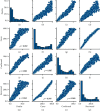Impact of Personal Protection Habits on the Spread of Pandemics: Insights from an Agent-Based Model
- PMID: 33859542
- PMCID: PMC8028727
- DOI: 10.1155/2021/6616654
Impact of Personal Protection Habits on the Spread of Pandemics: Insights from an Agent-Based Model
Abstract
Background: After several waves of spread of the COVID-19 pandemic, countries around the world are struggling to regain their economies by slowly lifting mobility restrictions and social distance measures applied during the crisis. Meanwhile, recent studies provide compelling evidence on how contact distancing, the use of face masks, and handwashing habits can reduce the risk of SARS-CoV-2 transmission. In this context, we investigated the effect that these personal protection habits can have in preventing new waves of contagion.
Methods: We extended an agent-based COVID-19 epidemic model in a simulated community to incorporate the mechanisms of these aforementioned personal care habits and measure their incidence in person-to-person transmission. A full factorial experiment design was performed to illustrate the extent to which the interplay between these personal habits is effective in mitigating the spread of disease. A global sensitivity analysis was performed on the parameters that control these habits to further validate the results.
Results: We found that observing physical distance is the dominant habit in reducing disease transmission, although adopting either or both of the other two habits is necessary to some extent to suppress a new outbreak entirely. When physical distance is not observed, adherence to the use of masks or handwashing has a significant decrease in infections and mortality, but the epidemic still unfolds. We also found that in all scenarios, the combined effect of adhering to the three habits is more powerful than adopting them separately.
Conclusions: Our findings suggest that a broad adherence of the population to voluntary self-care habits would help contain unfold of new outbreaks. The purpose of our model is illustrative and contributes to ratify the importance of urging citizens to adopt the amalgam of personal care habits as a primary collective protection measure to prevent communities from returning to confinements, while immunisation is carried out in late stages of the pandemic.
Copyright © 2021 Lindsay Álvarez-Pomar and Sergio Rojas-Galeano.
Conflict of interest statement
The authors declare that they have no conflicts of interest.
Figures










References
-
- Pichler A., Pangallo M., del Rio-Chanona R. M., Lafond F., Farmer J. D. Production networks and epidemic spreading: how to restart the UK economy? 2020. http://arxiv.org/abs/200510585.
-
- Fernandes N. Economic effects of coronavirus outbreak (COVID-19) on the world economy. 2020. - DOI
-
- Coibion O., Gorodnichenko Y., Weber M. The Cost of the COVID-19 Crisis: Lockdowns, Macroeconomic Expecta-Tions, and Consumer Spending. Cambridge, MA, USA: National Bureau of Economic Research; 2020.
-
- Ferguson N., Laydon D., Nedjati Gilani G., et al. Report 9: Impact of Non-pharmaceutical Interventions (NPIs) to Reduce COVID19 Mortality and Healthcare Demand. London, UK: Imperial College; 2020.
MeSH terms
LinkOut - more resources
Full Text Sources
Other Literature Sources
Medical
Miscellaneous

